 |
Scientific nameHyperaspis maindroni Sicard, 1929: 179. (=Hyperaspis maindroni ab. brumoides Sicard, Hyperaspis maindroni ab. includens Sicard)
Taxonomic positionColeoptera: Coccinellidae: Scymninae: Hyperaspidini
DiagnosisLength 2.16-2.70 mm, width 1.62-2.10 mm. Form oval, dorsoventrally somewhat flattened. Head yellow, eyes with brilliant metallic green reflection in live specimens. Pronotum yellow-orange, posterior margin with a dark brown to fuscous median area. Elytra pale creamy to luteous yellow, with three longitudinal black stripes, one on each elytron in a mid-dorsal position not reaching apex and one along sutural line reaching apex, elytral apex very narrowly bordered black; sometimes all stripes joined
together with a short stem near apex, forming a trident shaped marking. Posterior margin of elytra subtruncate, leaving abdominal tip slightly exposed. Postcoxal line on abdominal ventrite 1 nearly complete, reaching towards anterior margin of ventrite (Fig. 5). Male genitalia (Fig. 6-7) and female spermatheca (Fig. 8) as illustrated. Larva elliptical in outline, greyish, with powdery wax coating on dorsal surface. Pupa with the last larval skin vertically split along the middle, exposing the pupa.
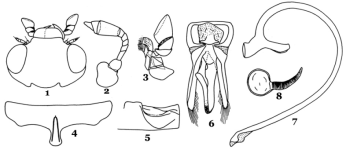 Figs. 1-8. Hyperaspis maindroni: 1. Head, dorsal view; 2. Antenna; 3. Maxilla; 4. Prosternum, showing intercoxal process; 5. Postcoxal line on abdominal ventrite 1; 6,7. Male genitalia: 6. Tegmen, ventral view; 7. Sipho; 8. Female spermatheca Brumoides suturalis is similar to this species in general appearance and coloration, but can be separated by its larger size, more convex body with apically rounded elytra, and other generic characters. Images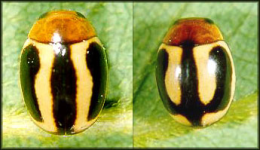 H. maindroni, nominate form and the form with trident-shaped elytral marking H. maindroni, nominate form and the form with trident-shaped elytral marking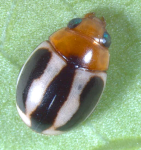
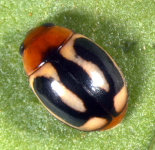
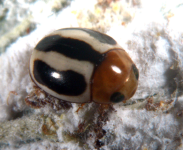
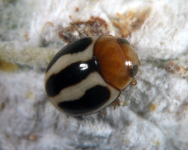
 Adult Adult
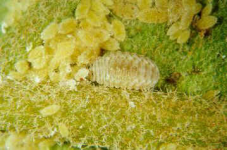 Larva feeding on Coccidohystrix insolita (Green) on brinjal Larva feeding on Coccidohystrix insolita (Green) on brinjal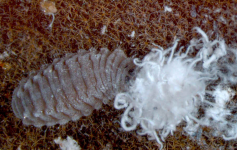
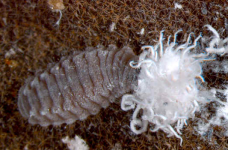 Larva feeding on mealybug Larva feeding on mealybug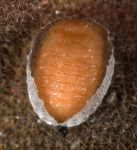
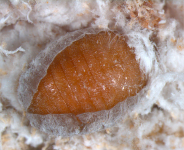
 Pupa of H. maindroni Pupa of H. maindroniDistributionIndia: Andhra Pradesh; Assam; Bihar; Karnataka; Madhya Pradesh; Tamil Nadu; Uttar Pradesh; West Bengal. (more common in southern states). Pakistan. Introduced and established in New Guinea
(Rao et al., 1971).
Prey / Associated habitatHEMIPTERA: Aphididae: Aphis fabae Scopoli, Aphis gossypii Glover,
Aphis spiraecola Patch (as A. citricola van der Goot), indeterminate aphids on Eupatorium sp. Coccoidea: Antonina graminis (Maskell), Ferrisia virgata (Cockerell), Coccidohystrix (as Centrococcus) insolita (Green), Maconellicoccus hirsutus (Green), Nipaecoccus viridis (Newstead), Planococcus lilacinus (Cockerell),
Pseudococcus corymbatus Ayyar, Pseudococcus sp., Rastrococcus iceryoides (Green),
Saccharicoccus sacchari (Cockerell), Trabutina (as Naiacoccus) sp. Associated with mealybugs and aphids infesting guava, sugarcane, mesta, cotton, pigeonpea, Boehmeria sp., coconut, and Rhodes grass.
Common on infestations of Coccidohystrix insolita on brinjal, Solanum torvum, other solanaceous plants, and pigeonpea. Seasonal occurrenceActive during summer months (March-May) on various hosts, particularly Boehmeria sp., in and around Bangalore (Puttarudriah & Channabasavanna, 1957). Collected during January-February, June-August (from Bangalore), June and October (from Assam), and March (Bihar).
References
|
